Pathogens and Infectious Diseases (A-level Biology)
Pathogens and Infectious Diseases
Pathogens
Pathogen refers to any organism which can cause disease. There are many forms of pathogens, such as viruses, bacteria, protoctists, and fungi.
Infectious diseases are medical conditions which are caused by pathogens, and are communicable or transmissible, meaning it can be passed on between hosts.
Table 1 lists infectious diseases which are caused by different types of pathogens.
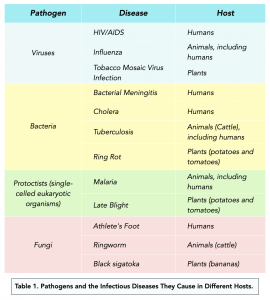
Transmission of Infectious Diseases
There are two ways in which infectious diseases can be transmitted:
- Direct transmission. This is when the pathogens are passed on directly between one host to another. Examples include:
- Droplet transmission. Breathing in droplets containing the pathogen which are produced by the coughing, sneezing, talking, and spitting of an infectious person.
- Sexual transmission. Having unprotected sexual intercourse with an infectious person
- Indirect transmission. This is when the pathogens are spread via an intermediary source before reaching the final host. Examples of intermediaries include:
-
- Water and food. An infectious person sheds the pathogen into a water/food source, which is then consumed by another person.
- Spores. Spores are the products of asexual reproduction, produced by organisms such as fungi, and some protoctist species. They also have the ability to cause disease when they gain entry into hosts.
- Vectors. Vectors are organisms which are first infected with the pathogen before passing the disease onto the final host. E.g. in malaria, infected mosquitoes act as vectors by spreading the causative protoctist to humans.
We will now look at five diseases and how they are transmitted in more detail.
Cholera
- Cholera is an infection by the bacterium Vibrio cholerae. The bacteria infects the small intestine of humans, causing profuse watery diarrhoea, vomiting, and muscle cramps.
- Cholera is transmitted via the faecal-oral route. Cholera is most commonly spread through consuming unclean water and food that is contaminated with human faeces containing the bacteria. Transmission mechanisms such as this is known as the faecal-oral route. It is not common for cholera to spread directly from person to person.
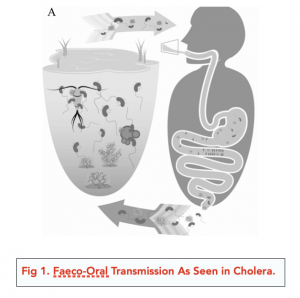
Malaria
- Malaria is caused by the parasites of the Plasmodium group. Plasmodium falciparum is the most common form of the parasite causing malaria, but other species of the Plasmodium group may also causes disease, such as Plasmodium malariae, Plasmodium ovale, and Plasmodium vivax. Symptoms of malaria include fever, headaches, and yellow skin.
- Malaria is transmitted via mosquitoes. Malaria is a vector-borne disease, meaning it is spread to humans through female mosquitoes which are first infected by the parasite. Female mosquitoes feed on blood unlike males, and the bite from the mosquito injects the parasites from the mosquito’s saliva into the person’s bloodstream. The parasites then mature and reproduce in the liver. The mature parasites then infect red blood cells, which can once again be taken up by mosquitoes when they bite an infected person, and this can be passed onto another human.
- Malaria is an endemic disease. As the transmission of malaria requires mosquitoes, malaria is usually only common in tropical and subtropical regions which have the hot and humid climates necessary for mosquitoes to breed. Thus, malaria is considered to be endemic to this region as there is a constant level of disease in that geographical area.
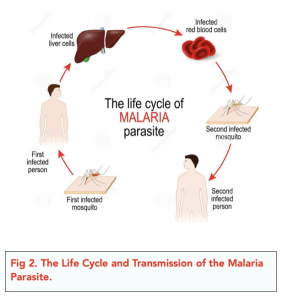
Tuberculosis
- Tuberculosis is caused by species of Mycobacterium. Mycobacterium tuberculosis causes tuberculosis (TB) in humans while Mycobacterium bovis causes the disease in cattle. TB is mainly a disease of the lungs but other parts of the body can also be affected.
- Tuberculosis is an airborne disease. In humans, TB can be transmitted directly from person to person (i.e. human-to-human transmission) via droplets in the air that are produced when a person with active TB speaks, coughs, sneezes, or spits. Those with close or prolonged contact with people who have active disease are at higher risk of becoming infected themselves.
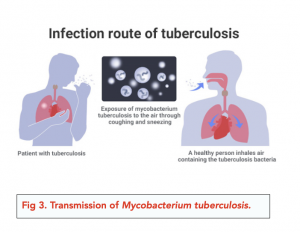
HIV/AIDS
- HIV/AIDS is caused by the human immunodeficiency virus. The human immunodeficiency virus attacks key cells of the immune system, such that over time, the infected person develops acquired immunodeficiency syndrome (AIDS), where the immune system becomes progressively weaker due to depletion of immune cells. This exposes the person to other infections and cancers that may ultimately become fatal.
- HIV is transmitted through certain body fluids. There are certain body fluids that can pass on the human immunodeficiency virus (HIV), such as blood, semen, and breast milk. These fluids must come in contact with certain structures, such as mucous membranes or damaged tissues, or they must be directly injected into the bloodstream. Example transmission routes include:
- Sexual transmission. Transmission of HIV via unprotected sexual intercourse with an infected person is usually the most common route.
- Direct injection into the bloodstream. This most commonly occurs via sharing of needles or syringes among intravenous drug users. A far less common route is the transfusion of blood and blood products contaminated with HIV.
- Vertical transmission. This refers to the passing of the virus from an infected mother to her baby through the placenta during pregnancy.
- Breastfeeding. Breast milk can contain HIV which can be passed onto the child during breastfeeding. Thus, the WHO recommends infected mothers to avoid breastfeeding if they have access to alternative forms of nutrition for their babies.
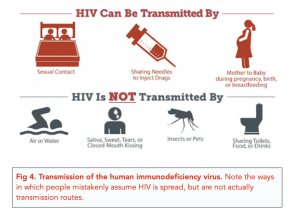
Stem rust
- Stem rust is caused by Puccinia graminis. Stem rust (also known as black/cereal rust) is a serious infection in plants caused by the fungus Puccina graminis. Commonly affected crops include different types of wheat and barley.
- Stem rust is transmitted via spores. Puccina graminis produce spores for reproduction. The most common form of spores are usually deposited to nearby plants, but there are other forms that can travel long-distances. When spores land on its host plant, they form a reddish-brown pustule, called uredinia. This leads to the breakdown of the outer layers of the stalk, resulting in excessive evaporation and weakening of the plant.
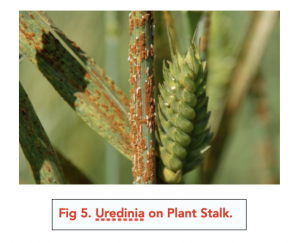
Preventing Transmission of Infectious Diseases in Humans
As diseases have serious consequences to both the infected person and their communities, it is important to prevent them from occurring them in the first place. Prevention of diseases require consideration of social, economic, and biological factors. This is because:
- Diseases usually spread rapidly in densely populated, unsanitary areas.
- Countries that are able to invest in good healthcare systems and public health education campaigns are more successful in preventing diseases. Their populations are more educated on good hygienic practices that prevent transmissions, and are aware of treatment and vaccination programmes.
Table 2 lists specific strategies that help prevent diseases.
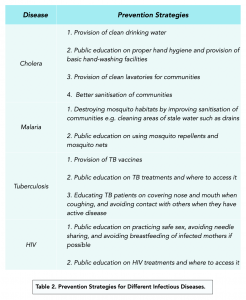
FAQs
Pathogens are microorganisms such as bacteria, viruses, fungi or parasites that can cause disease in living organisms.
There are four main types of pathogens: bacteria, viruses, fungi, and parasites.
Pathogens can cause disease by producing toxins, invading and damaging host cells, or disrupting normal bodily functions.
Viruses are smaller and simpler than bacteria, they can only reproduce by invading host cells and using their cellular machinery. Bacteria are single-celled organisms that can reproduce on their own.
Infectious diseases can spread through contact with contaminated surfaces, through the air, through bites from infected insects, or through sexual contact.
Practicing good hygiene, such as frequent hand-washing and covering your mouth when you cough or sneeze, can help to prevent the spread of infectious diseases by reducing the transfer of pathogens from person to person.
Immunity is the body’s ability to recognize and defend against pathogens. This can occur through previous exposure to a pathogen, vaccination, or the development of natural immunity over time.
Vaccination is the process of administering a weakened or dead form of a pathogen to stimulate the body’s immune system to produce an immune response. This prepares the body to recognize and defend against the pathogen if it is encountered again in the future.
The benefits of vaccination include protection against infectious diseases, reduced spread of diseases within communities, and the prevention of outbreaks and epidemics. The risks of vaccination include side effects such as pain, swelling or redness at the injection site, and in rare cases, allergic reactions.
Examples of infectious diseases include the flu, tuberculosis, HIV/AIDS, chickenpox, and hepatitis B.





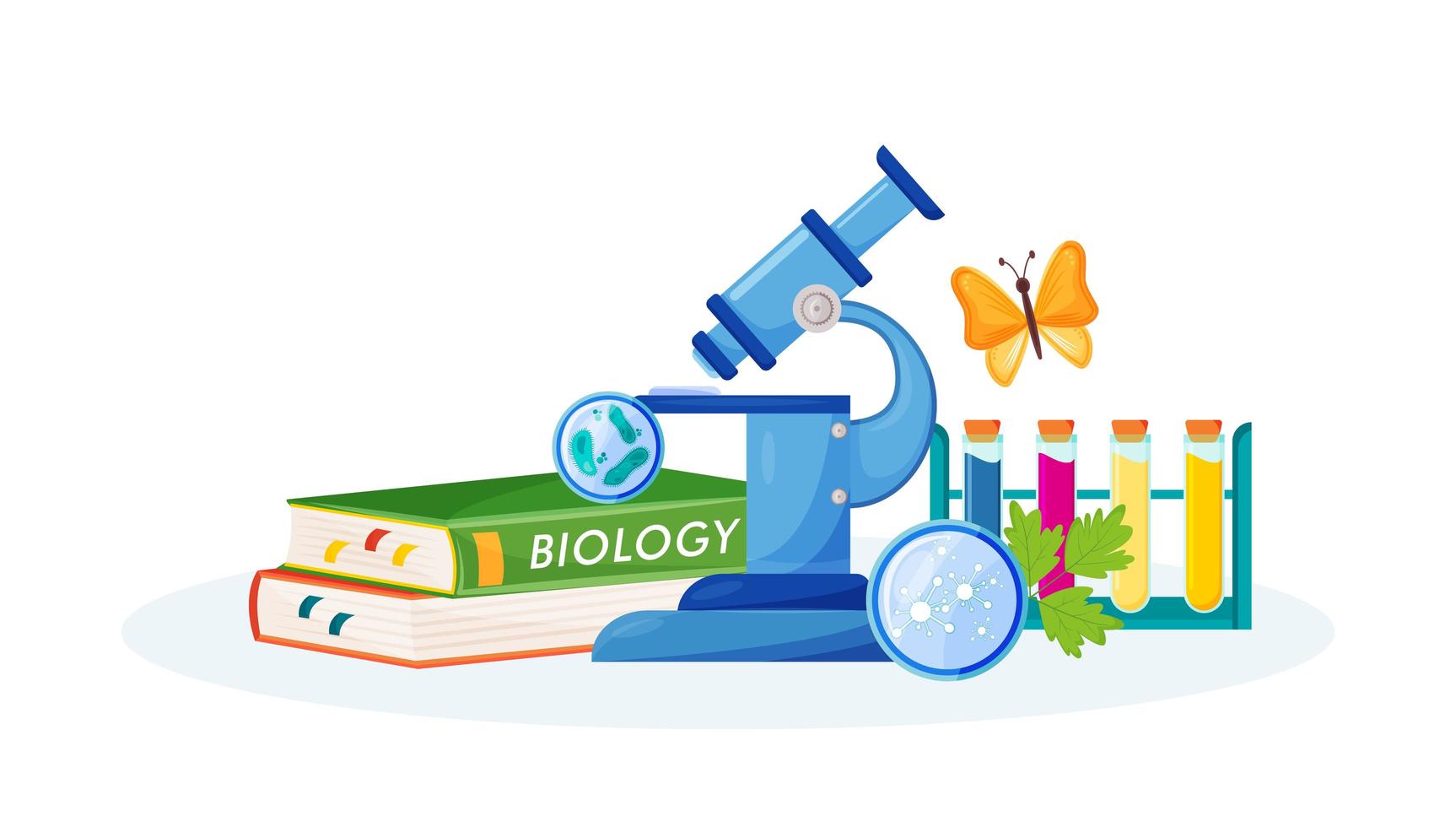
Still got a question? Leave a comment
Leave a comment